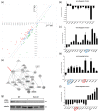Analysis of Tks4 Knockout Mice Suggests a Role for Tks4 in Adipose Tissue Homeostasis in the Context of Beigeing
- PMID: 31387265
- PMCID: PMC6721678
- DOI: 10.3390/cells8080831
Analysis of Tks4 Knockout Mice Suggests a Role for Tks4 in Adipose Tissue Homeostasis in the Context of Beigeing
Abstract
Obesity and adipocyte malfunction are related to and arise as consequences of disturbances in signaling pathways. Tyrosine kinase substrate with four Src homology 3 domains (Tks4) is a scaffold protein that establishes a platform for signaling cascade molecules during podosome formation and epidermal growth factor receptor (EGFR) signaling. Several lines of evidence have also suggested that Tks4 has a role in adipocyte biology; however, its roles in the various types of adipocytes at the cellular level and in transcriptional regulation have not been studied. Therefore, we hypothesized that Tks4 functions as an organizing molecule in signaling networks that regulate adipocyte homeostasis. Our aims were to study the white and brown adipose depots of Tks4 knockout (KO) mice using immunohistology and western blotting and to analyze gene expression changes regulated by the white, brown, and beige adipocyte-related transcription factors via a PCR array. Based on morphological differences in the Tks4-KO adipocytes and increased uncoupling protein 1 (UCP1) expression in the white adipose tissue (WAT) of Tks4-KO mice, we concluded that the beigeing process was more robust in the WAT of Tks4-KO mice compared to the wild-type animals. Furthermore, in the Tks4-KO WAT, the expression profile of peroxisome proliferator-activated receptor gamma (PPARγ)-regulated adipogenesis-related genes was shifted in favor of the appearance of beige-like cells. These results suggest that Tks4 and its downstream signaling partners are novel regulators of adipocyte functions and PPARγ-directed white to beige adipose tissue conversion.
Keywords: Tks4 scaffold protein; WAT browning; adipogenesis; beige adipocytes.
Conflict of interest statement
The authors declare no conflict of interest.
Figures




Similar articles
-
Endoplasmic Reticulum Stress Impaired Uncoupling Protein 1 Expression via the Suppression of Peroxisome Proliferator-Activated Receptor γ Binding Activity in Mice Beige Adipocytes.Int J Mol Sci. 2019 Jan 11;20(2):274. doi: 10.3390/ijms20020274. Int J Mol Sci. 2019. PMID: 30641938 Free PMC article.
-
Coordinate functional regulation between microsomal prostaglandin E synthase-1 (mPGES-1) and peroxisome proliferator-activated receptor γ (PPARγ) in the conversion of white-to-brown adipocytes.J Biol Chem. 2013 Sep 27;288(39):28230-42. doi: 10.1074/jbc.M113.468603. Epub 2013 Aug 13. J Biol Chem. 2013. PMID: 23943621 Free PMC article.
-
Theobromine enhances the conversion of white adipocytes into beige adipocytes in a PPARγ activation-dependent manner.J Nutr Biochem. 2022 Feb;100:108898. doi: 10.1016/j.jnutbio.2021.108898. Epub 2021 Nov 5. J Nutr Biochem. 2022. PMID: 34748921
-
Second messenger signaling mechanisms of the brown adipocyte thermogenic program: an integrative perspective.Horm Mol Biol Clin Investig. 2017 Sep 26;31(2):/j/hmbci.2017.31.issue-2/hmbci-2017-0062/hmbci-2017-0062.xml. doi: 10.1515/hmbci-2017-0062. Horm Mol Biol Clin Investig. 2017. PMID: 28949928 Review.
-
White, brown, beige/brite: different adipose cells for different functions?Endocrinology. 2013 Sep;154(9):2992-3000. doi: 10.1210/en.2013-1403. Epub 2013 Jun 19. Endocrinology. 2013. PMID: 23782940 Review.
Cited by
-
Studying the Association of TKS4 and CD2AP Scaffold Proteins and Their Implications in the Partial Epithelial-Mesenchymal Transition (EMT) Process.Int J Mol Sci. 2023 Oct 13;24(20):15136. doi: 10.3390/ijms242015136. Int J Mol Sci. 2023. PMID: 37894817 Free PMC article.
-
Absence of the Tks4 Scaffold Protein Induces Epithelial-Mesenchymal Transition-Like Changes in Human Colon Cancer Cells.Cells. 2019 Oct 29;8(11):1343. doi: 10.3390/cells8111343. Cells. 2019. PMID: 31671862 Free PMC article.
-
A Novel Cell-Based Model for a Rare Disease: The Tks4-KO Human Embryonic Stem Cell Line as a Frank-Ter Haar Syndrome Model System.Int J Mol Sci. 2022 Aug 8;23(15):8803. doi: 10.3390/ijms23158803. Int J Mol Sci. 2022. PMID: 35955935 Free PMC article.
-
SIRT3 regulates cardiolipin biosynthesis in pressure overload-induced cardiac remodeling by PPARγ-mediated mechanism.PLoS One. 2024 Apr 16;19(4):e0301990. doi: 10.1371/journal.pone.0301990. eCollection 2024. PLoS One. 2024. PMID: 38625851 Free PMC article.
-
Advances in Understanding TKS4 and TKS5: Molecular Scaffolds Regulating Cellular Processes from Podosome and Invadopodium Formation to Differentiation and Tissue Homeostasis.Int J Mol Sci. 2020 Oct 30;21(21):8117. doi: 10.3390/ijms21218117. Int J Mol Sci. 2020. PMID: 33143131 Free PMC article. Review.
References
-
- Kleinendorst L., Massink M.P.G., Cooiman M.I., Savas M., vanderBaan-Slootweg O.H., Roelants R.J., Janssen I.C.M., Meijers-Heijboer H.J., Knoers N.V.A.M., Ploosvan Amstel H.K., et al. Geneticobesity: Next-generations equencing results of 1230 patients with obesity. J. Med. Genet. 2018;55:578–586. doi: 10.1136/jmedgenet-2018-105315. - DOI - PubMed
-
- Senese R., Cioffi F., DeMatteis R., Petito G., deLange P., Silvestri E., Lombardi A., Moreno M., Goglia F., Lanni A. 3,5 Diiodo-l-Thyronine (T₂) Promotes the Browning of White Adipose Tissue in High-Fat Diet-Induced Overweight Male Rats Housed at Thermoneutrality. Cells. 2019;8:256. doi: 10.3390/cells8030256. - DOI - PMC - PubMed
Publication types
MeSH terms
Substances
LinkOut - more resources
Full Text Sources
Other Literature Sources
Molecular Biology Databases
Research Materials
Miscellaneous

